Numerical and Experimental Study on a Novel Filling Support Method for Mining of Closely Spaced Multilayer Orebody
Abstract
:1. Introduction
2. Bolt-Filling Support Method and System
3. Numerical Simulation Study of Bolt-Filling Support
3.1. Calibration of the Microscopic Parameters
3.2. Fracture Expansion of Surrounding Rock and Distribution Law of Force Chain
3.2.1. Upper Goaf Not Supported
3.2.2. Upper Goaf 100% Filled
3.2.3. Upper Goaf 95% Filled
3.2.4. Bolt-Filling Support
4. Similarity Simulation Experiment of Bolt-Filling Support
4.1. Similarity Experiment Design
4.1.1. Similarity Constants
- (1)
- Geometric Similarity Constant
- (2)
- Bulk Density Similarity Constant
- (3)
- Strength Similarity Constant
- (4)
- Time Similarity Constant
4.1.2. Selection and Preparation of Similarity Experiment Materials
4.1.3. Similarity Model Building
4.2. The Similarity Simulation Experiment Process
4.2.1. Arrangement of Strain Gages
4.2.2. Similarity Experiment 1: Excavation of Double-Layer Ore Body without Support
4.2.3. Similarity Experiment 2: Excavation of Double-Layer Ore Body with Support
4.3. Experiment Results
4.3.1. Results of Experiment 1
4.3.2. Results of Experiment 2
5. Discussion
6. Conclusions
- (1)
- A novel bolt-filling support method is proposed in this research.
- (2)
- It is revealed that, by numerical simulation of fracture distribution and force chains, bolt-filling support not only reduces the roof load of the lower goaf, but also helps to relieve the tensile stress concentration in the roof of the upper goaf caused by incomplete filling, which is effective for the support of closely spaced multilayer goaf.
- (3)
- It is found that, by similarity experiments, the deformation of the roof and interlayer under bolt-filling support is the smallest, which has a high consistency with the numerical simulation results.
- (4)
- Therefore, it is safe to say that the bolt-filling support performs better than other conventional support methods for mining closely spaced multilayer orebodies, so that to promote mining safety and the stability of the roof and interlayer.
7. Patents
Author Contributions
Funding
Data Availability Statement
Acknowledgments
Conflicts of Interest
References
- Li, A. Caving spacing study for the flat inclined layered ore-body by mathews method. China Min. Mag. 2007, 16, 67–69. [Google Scholar]
- Merad, M.M.; Verdel, T.; Roy, B.; Kouniali, S. Use of multi-criteria decision-aids for risk zoning and management of large area subjected to mining-induced hazards. Tunn. Undergr. Space Technol. 2004, 19, 125–138. [Google Scholar]
- Yan, B.; Wang, P.; Ren, F.; Guo, Q.; Cai, M. A Review of Mechanical Properties and Constitutive Theory of Rock Mass Anisotropy. Arab. J. Geosci. 2020, 13, 487. [Google Scholar]
- Burtan, Z.; Chlebowski, D. The Effect of Mining Remnants on Elastic Strain Energy Arising in the Tremor-Inducing Layer. Energies 2022, 15, 6031. [Google Scholar]
- Zhang, C.; Wang, Y.; Ruan, H.; Ke, B.; Lin, H. The Strain Characteristics and Corresponding Model of Rock Materials under Uniaxial Cyclic Load/Unload Compression and Their Deformation and Fatigue Damage Analysis. Arch. Appl. Mech. 2021, 91, 2481–2496. [Google Scholar]
- Cai, W.; Dou, L.; Ju, Y.; Cao, W.; Yuan, S.; Si, G. A Plastic Strain-Based Damage Model for Heterogeneous Coal Using Cohesion and Dilation Angle. Int. J. Rock Mech. Min. Sci. 2018, 110, 151–160. [Google Scholar]
- Zhao, Y.; Zhang, L.; Wang, W.; Wan, W.; Ma, W. Separation of elastoviscoplastic strains of rock and a nonlinear creep model. Int. J. Geomech. 2018, 18, 04017129. [Google Scholar]
- Zhang, C.; Wang, Y.; Jiang, T. The Propagation Mechanism of an Oblique Straight Crack in a Rock Sample and the Effect of Osmotic Pressure under In-Plane Biaxial Compression. Arab. J. Geosci. 2020, 13, 736. [Google Scholar]
- Al-Shayea, N.A. Crack Propagation Trajectories for Rocks under Mixed Mode I–II Fracture. Eng. Geol. 2005, 81, 84–97. [Google Scholar]
- Zhao, Y.; Zhang, L.; Liao, J.; Wang, W.; Liu, Q.; Tang, L. Experimental study of fracture toughness and subcritical crack growth of three rocks under different environments. Int. J. Geomech. 2020, 20, 04020128. [Google Scholar]
- Yang, H.; Lin, H.; Chen, Y.; Wang, Y.; Zhao, Y.; Yong, W.; Gao, F. Influence of Wing Crack Propagation on the Failure Process and Strength of Fractured Specimens. Bull. Eng. Geol. Environ. 2022, 81, 71. [Google Scholar]
- Gontarz, J.; Podgórski, J. Numerical Analysis of Crack Propagation in a Pull-out Test. MATEC Web Conf. 2019, 252, 08001. [Google Scholar]
- Sher, E.N. Numerical Evaluation of Wedge Penetration Resistance in Brittle Rock Mass with Regard to Equilibrium Propagation of Main Crack. J. Min. Sci. 2021, 57, 955–964. [Google Scholar]
- Yang, H.; Lin, H.; Wang, Y.; Cao, R.; Li, J.; Zhao, Y. Investigation of the Correlation between Crack Propagation Process and the Peak Strength for the Specimen Containing a Single Pre-Existing Flaw Made of Rock-like Material. Arch. Civ. Mech. Eng. 2021, 21, 68. [Google Scholar]
- Lin, H.; Yang, H.; Wang, Y.; Zhao, Y.; Cao, R. Determination of the Stress Field and Crack Initiation Angle of an Open Flaw Tip under Uniaxial Compression. Theor. Appl. Fract. Mech. 2019, 104, 102358. [Google Scholar]
- Zhao, Y.; Wang, Y.; Wang, W.; Tang, L.; Liu, Q.; Cheng, G. Modeling of Rheological Fracture Behavior of Rock Cracks Subjected to Hydraulic Pressure and Far Field Stresses. Theor. Appl. Fract. Mech. 2019, 101, 59–66. [Google Scholar]
- Wang, Y.; Zhang, H.; Lin, H.; Zhao, Y.; Liu, Y. Fracture Behaviour of Central-Flawed Rock Plate under Uniaxial Compression. Theor. Appl. Fract. Mech. 2020, 106, 102503. [Google Scholar]
- Li, X.; Peng, J.; Xie, Y.; Li, Q.; Zhou, T.; Wang, J.; Zheng, W. Influence of High-Temperature Treatment on Strength and Failure Behaviors of a Quartz-Rich Sandstone under True Triaxial Condition. Lithosphere 2022, 2022, 3086647. [Google Scholar]
- Zhang, S.; Lin, H.; Chen, Y.; Wang, Y.; Zhao, Y. Acoustic Emission and Failure Characteristics of Cracked Rock under Freezing-Thawing and Shearing. Theor. Appl. Fract. Mech. 2022, 121, 103537. [Google Scholar]
- Jonak, J.; Siegmund, M.; Karpiński, R.; Wójcik, A. Three-Dimensional Finite Element Analysis of the Undercut Anchor Group Effect in Rock Cone Failure. Materials 2020, 13, 1332. [Google Scholar]
- Zhao, Y.; Zhao, G.; Zhou, J.; Ma, J.; Cai, X. Failure mechanism analysis of rock in particle discrete element method simulation based on moment tensors. Comput. Geotech. 2021, 136, 104215. [Google Scholar]
- Ghorbani, M.; Shahriar, K.; Sharifzadeh, M.; Masoudi, R.A. Critical Review on the Developments of Rock Support Systems in High Stress Ground Conditions. Int. J. Min. Sci. Technol. 2020, 30, 555–572. [Google Scholar]
- Yasuda, N. An Analytical Model for Ground Support by Bolting. Int. J. Numer. Anal. Methods Geomech. 2022, 46, 3425–3441. [Google Scholar]
- Wu, K.; Shao, Z.; Li, C.; Qin, S. Theoretical Investigation to the Effect of Bolt Reinforcement on Tunnel Viscoelastic Behavior. Arab. J. Sci. Eng. 2020, 45, 3707–3718. [Google Scholar]
- Herezy, Ł.; Korzeniowski, W.; Skrzypkowski, K. Laboratory Method for Evaluating the Characteristics of Expansion Rock Bolts Subjected to Axial Tension. Arch. Min. Sci. 2015, 1, 209–224. [Google Scholar]
- Haile, A.T.; Le Bron, K. Simulated Rockburst Experiment—Evaluation of Rock Bolt Reinforcement Performance. J. S. Afr. Inst. Min. Metall. 2001, 101, 247–251. [Google Scholar]
- Zakharov, V.N.; Trofimov, V.A.; Filippov, Y.A. Numerical Modeling of Rock Bolt Support in Case of Rheological Behavior of Rock Mass in Deformation. J. Min. Sci. 2021, 57, 883–893. [Google Scholar]
- Boon, C.W. Study of Reinforcement Support Mechanisms for Wide-Span Horse-Shoe-Shaped Openings in Horizontally Layered Jointed Rock Using the Distinct Element Method. Rock Mech. Rock Eng. 2019, 52, 1179–1191. [Google Scholar]
- Nguyen, T.; Ghabraie, K.; Tran-Cong, T. Simultaneous Pattern and Size Optimisation of Rock Bolts for Underground Excavations. Comput. Geotech. 2015, 66, 264–277. [Google Scholar]
- Zhang, C.; Pu, C.; Cao, R.; Jiang, T.; Huang, G. The Stability and Roof-Support Optimization of Roadways Passing through Unfavorable Geological Bodies Using Advanced Detection and Monitoring Methods, among Others, in the Sanmenxia Bauxite Mine in China’s Henan Province. Bull. Eng. Geol. Environ. 2019, 78, 5087–5099. [Google Scholar]
- Ito, F.; Nakahara, F.; Kawano, R.; Kang, S.-S.; Obara, Y. Visualization of Failure in a Pull-out Test of Cable Bolts Using X-Ray CT. Constr. Build. Mater. 2001, 15, 263–270. [Google Scholar]
- Tahmasebinia, F.; Zhang, C.; Canbulat, I.; Vardar, O.; Saydam, S. Numerical and Analytical Simulation of the Structural Behaviour of Fully Grouted Cable Bolts under Impulsive Loading. Int. J. Min. Sci. Technol. 2018, 28, 807–811. [Google Scholar]
- Singh, S.K.; Raval, S.; Banerjee, B. A Robust Approach to Identify Roof Bolts in 3D Point Cloud Data Captured from a Mobile Laser Scanner. Int. J. Min. Sci. Technol. 2021, 31, 303–312. [Google Scholar]
- Sui, Q.; He, M.; He, P.; Xia, M.; Tao, Z. State of the Art Review of the Large Deformation Rock Bolts. Undergr. Space 2022, 7, 465–482. [Google Scholar]
- Lv, W.Y.; Zhang, Z.H. Current Situation and Prospect of Coal Backfill Mining Technology. Adv. Mater. Res. 2012, 524, 421–425. [Google Scholar]
- Bazaluk, O.; Petlovanyi, M.; Lozynskyi, V.; Zubko, S.; Sai, K.; Saik, P. Sustainable Underground Iron Ore Mining in Ukraine with Backfilling Worked-Out Area. Sustainability 2021, 13, 834. [Google Scholar]
- Seryakov, V.M. Stress Determination in Rock Mass with Regard to Sequence of Deep-Level Cut-and-Fill. J. Min. Sci. 2021, 57, 894–900. [Google Scholar]
- Yang, K.; Zhao, X.; Wei, Z.; Zhang, J. Development Overview of Paste Backfill Technology in China’s Coal Mines: A Review. Environ. Sci. Pollut. Res. 2021, 28, 67957–67969. [Google Scholar]
- Yin, S.; Shao, Y.; Wu, A.; Wang, H.; Liu, X.; Wang, Y. A Systematic Review of Paste Technology in Metal Mines for Cleaner Production in China. J. Clean. Prod. 2020, 247, 119590. [Google Scholar]
- Benzaazoua, M.; Fall, M.; Belem, T. A contribution to understanding the hardening process of cemented pastefill. Miner. Eng. 2004, 17, 141–152. [Google Scholar]
- Raffaldi, M.J.; Seymour, J.B.; Richardson, J.; Zahl, E.; Board, M. Cemented Paste Backfill Geomechanics at a Narrow-Vein Underhand Cut-and-Fill Mine. Rock Mech. Rock Eng. 2019, 52, 4925–4940. [Google Scholar]
- Belem, T.; Benzaazoua, M. Design and application of underground mine paste backfill technology. Geotech. Geol. Eng. 2008, 26, 147–174. [Google Scholar]
- Shaposhnik, Y.N.; Konurin, A.I.; Neverov, A.A.; Neverov, S.A.; Usol’tseva, O.M.; Shaposhnik, S.N. Validation of Friction-Anchored Rock Bolt Supports for Underground Excavations in Backfill. J. Min. Sci. 2021, 57, 775–786. [Google Scholar]
- Wuhan University of Technology. Bolt-Filling Support Method and System for Closely Spaced Multiplayer Orebody. CN114294032A, 4 August 2022.
- Chi, X.; Xie, Y.; Chen, D.; Wang, Z.; Deng, X.; Zhao, L. Study on Meso-Parameter Calibration and Roof Fracture Law of Vanadium-Bearing Shale Ore. Min. Res. Dev. 2022, in press. [Google Scholar]
- Chen, Q.; Zhou, K. Action mechanism of low-grade backfill on stability of mining environment structure. Rock Soil Mech. 2010, 31, 2811–2816. [Google Scholar]
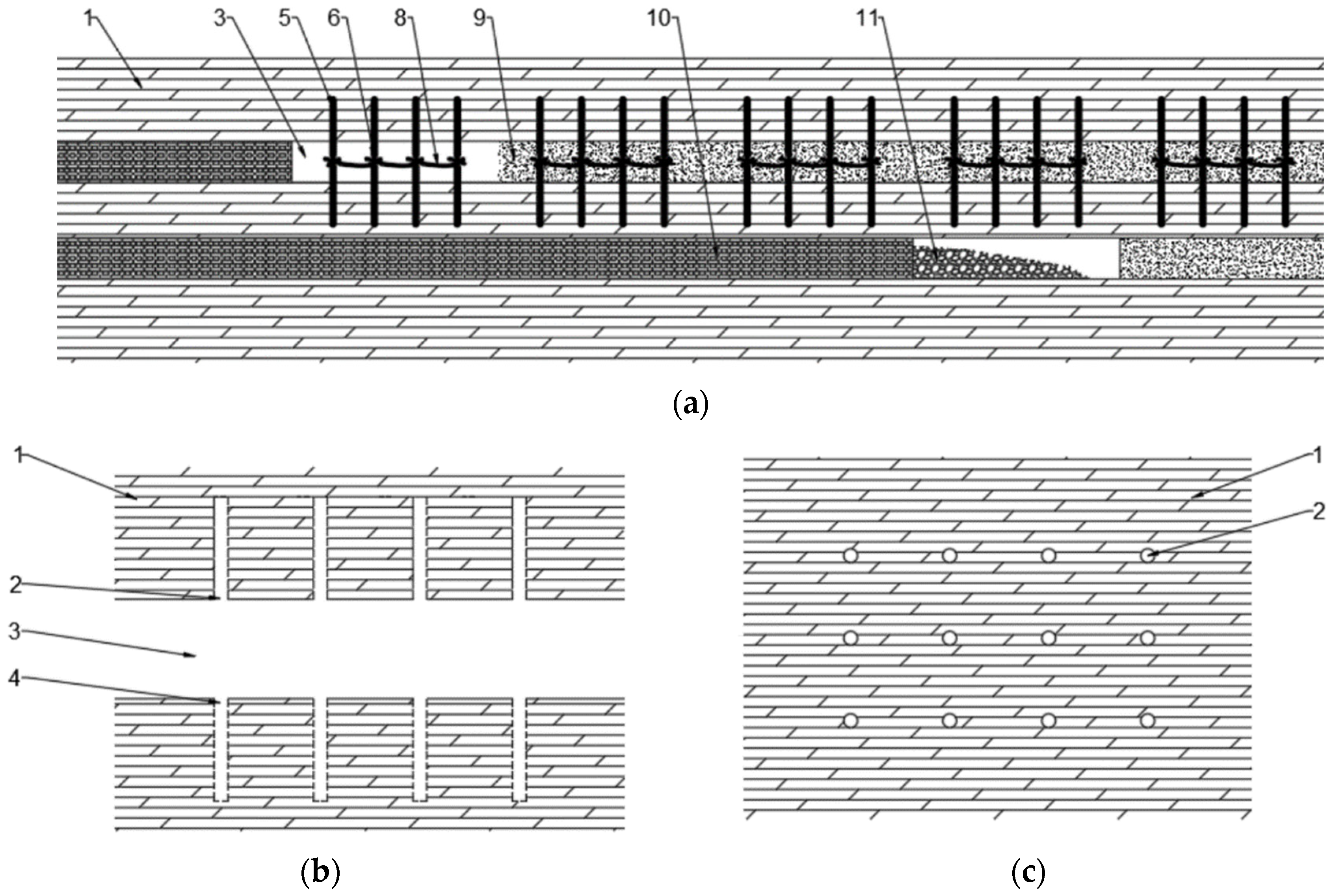
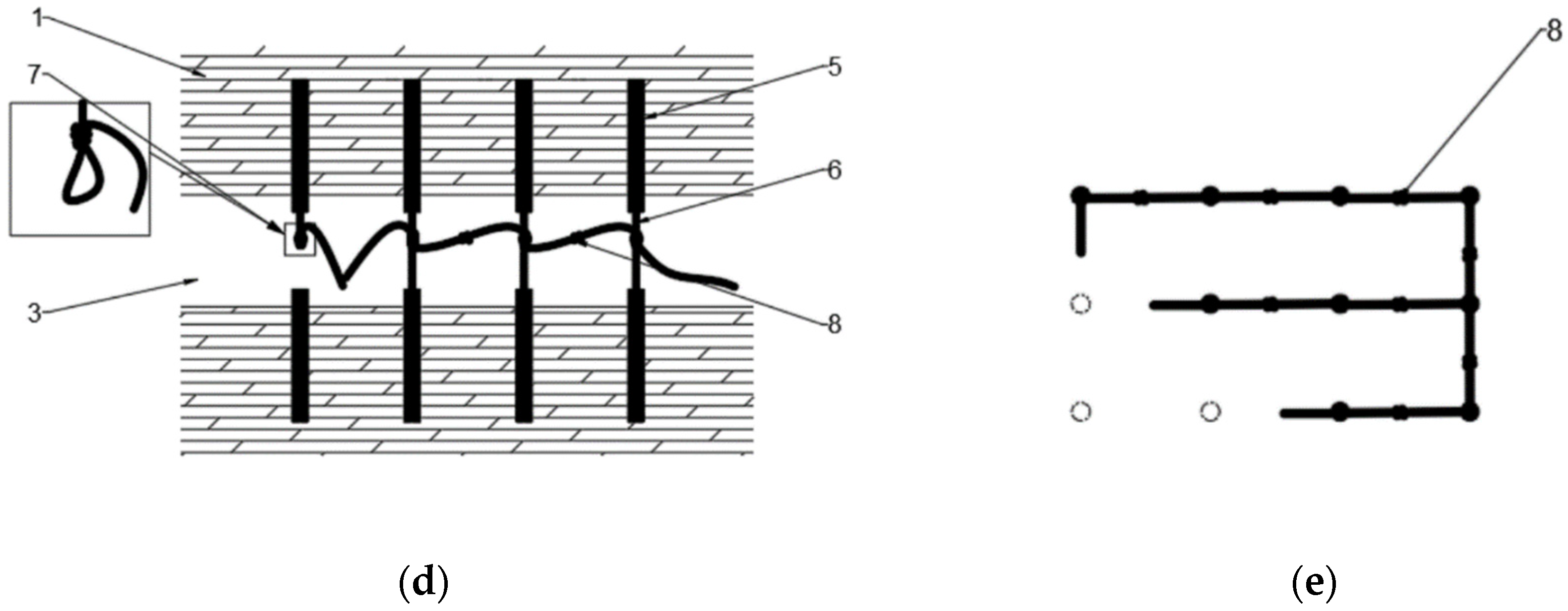
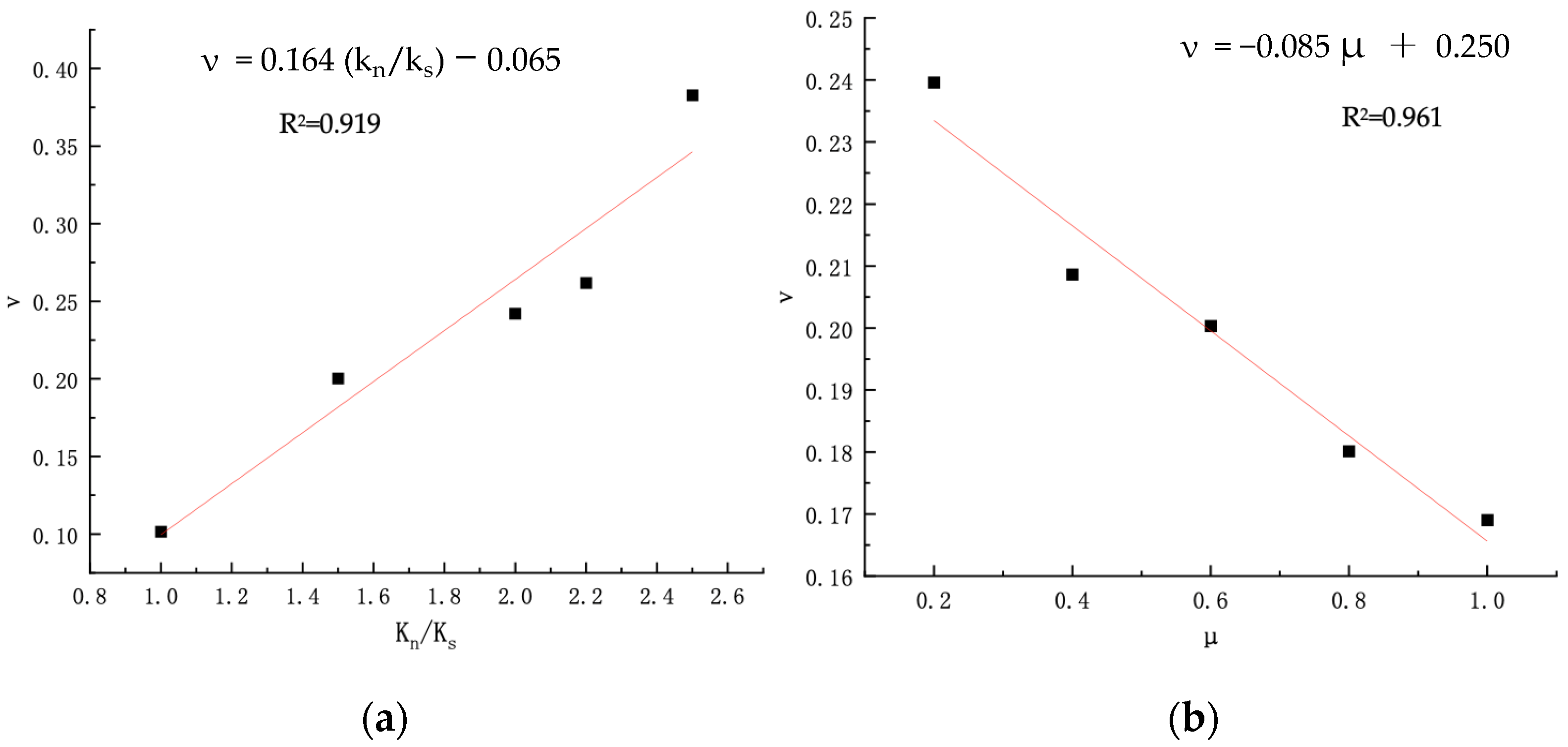


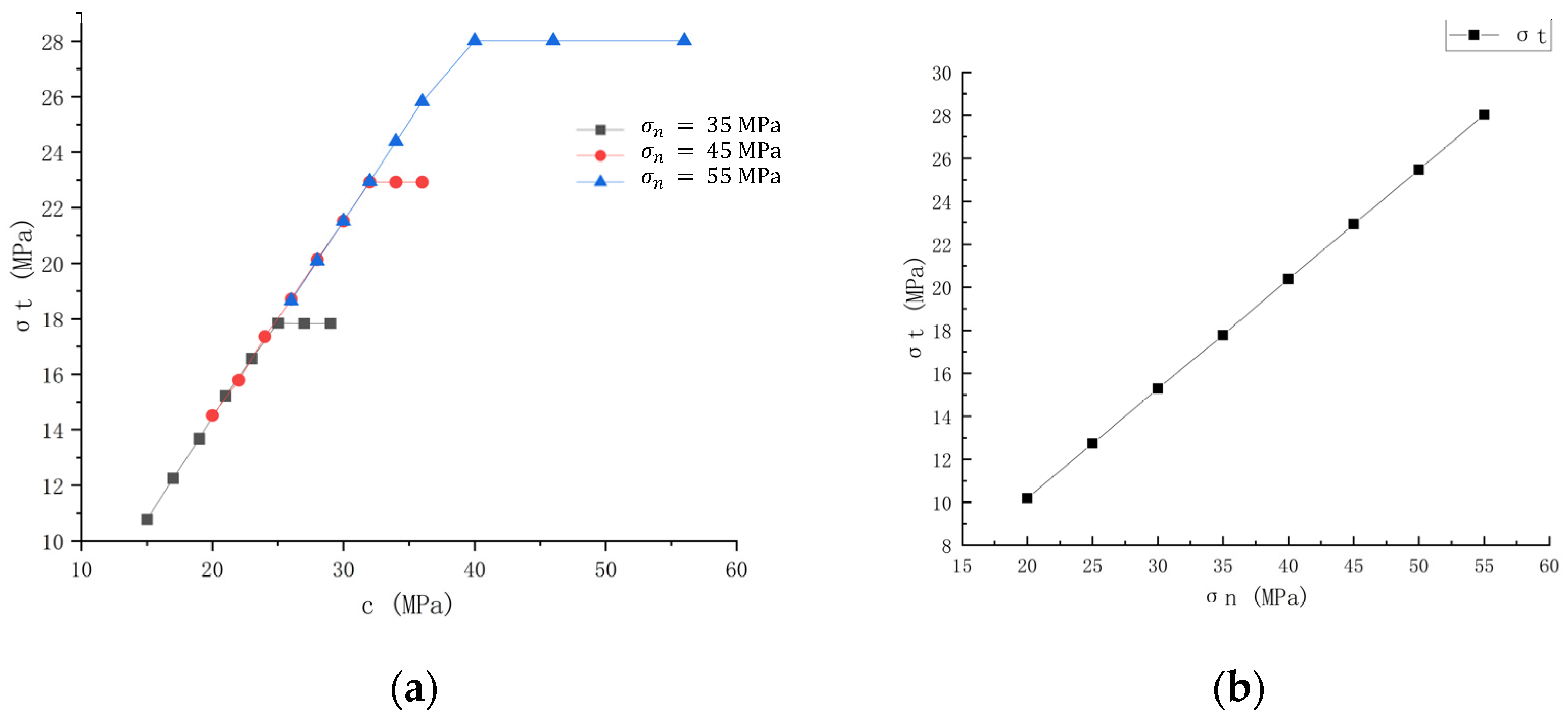
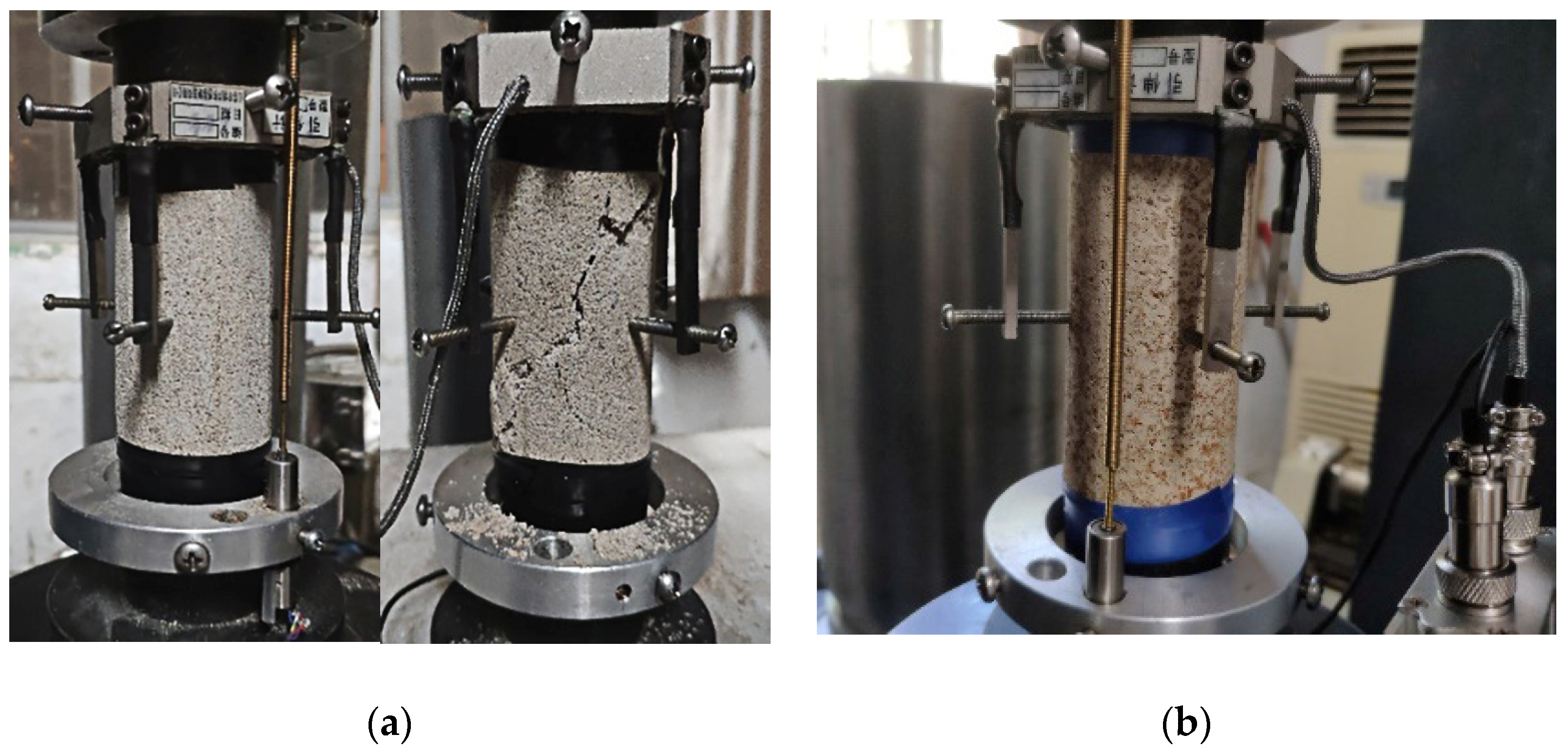
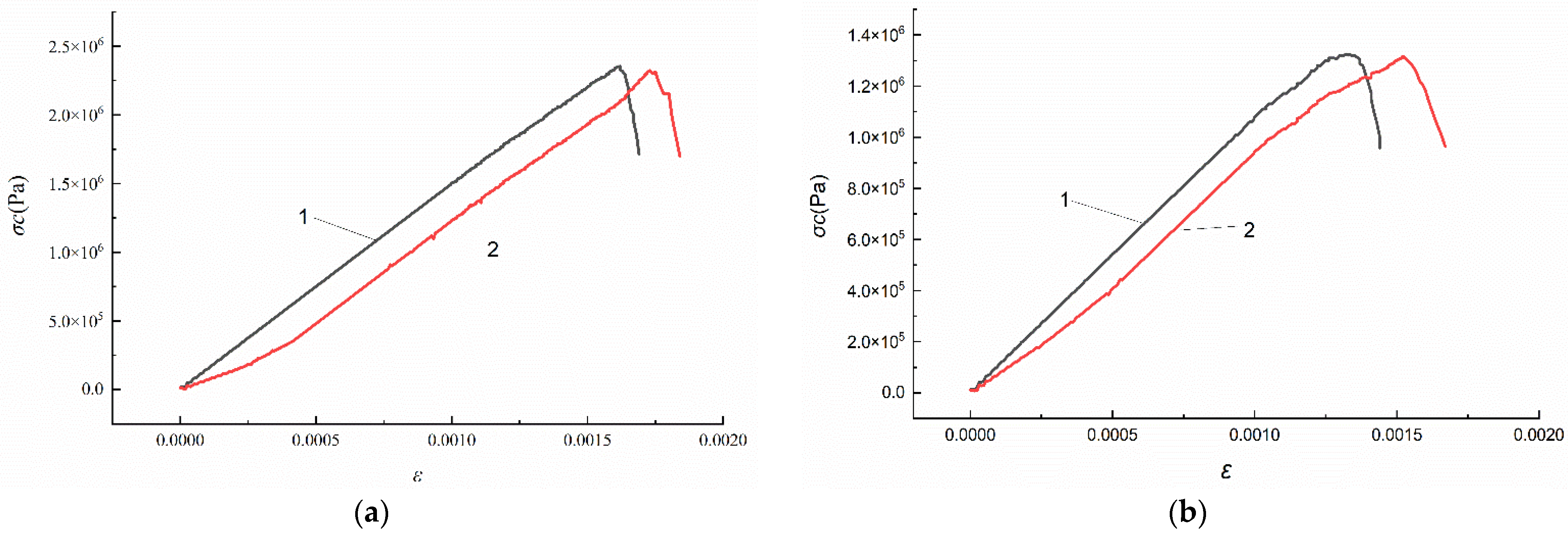

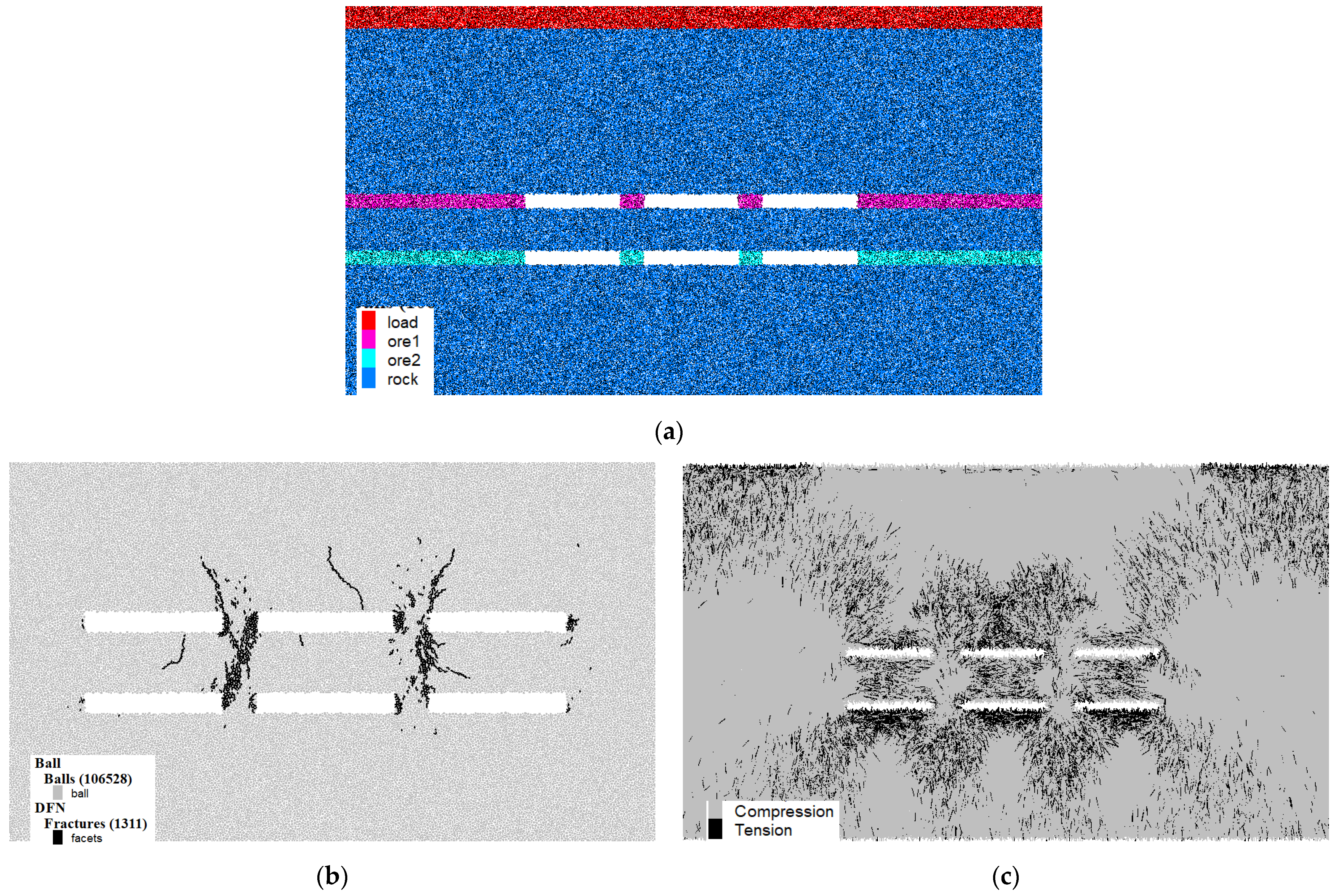
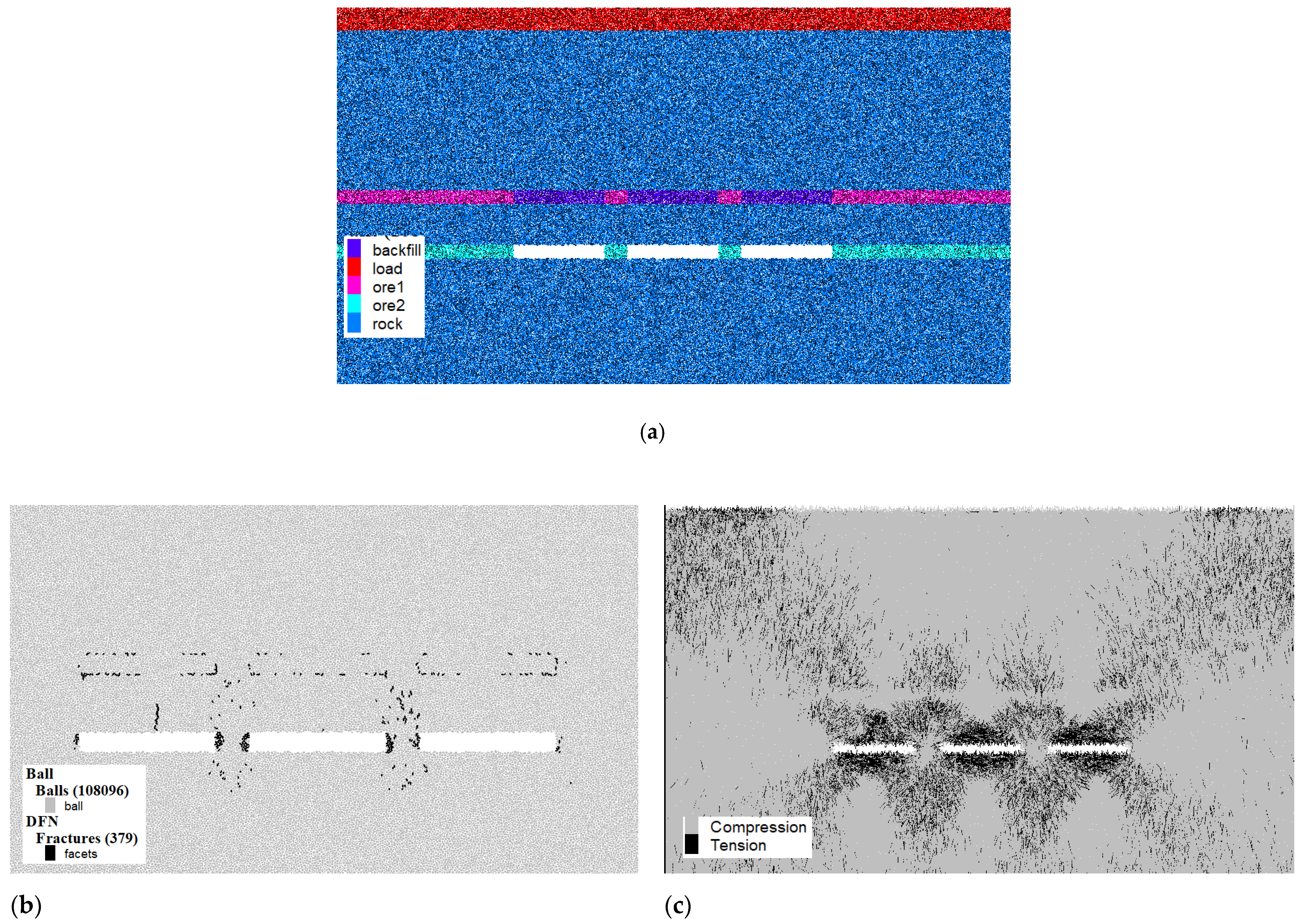
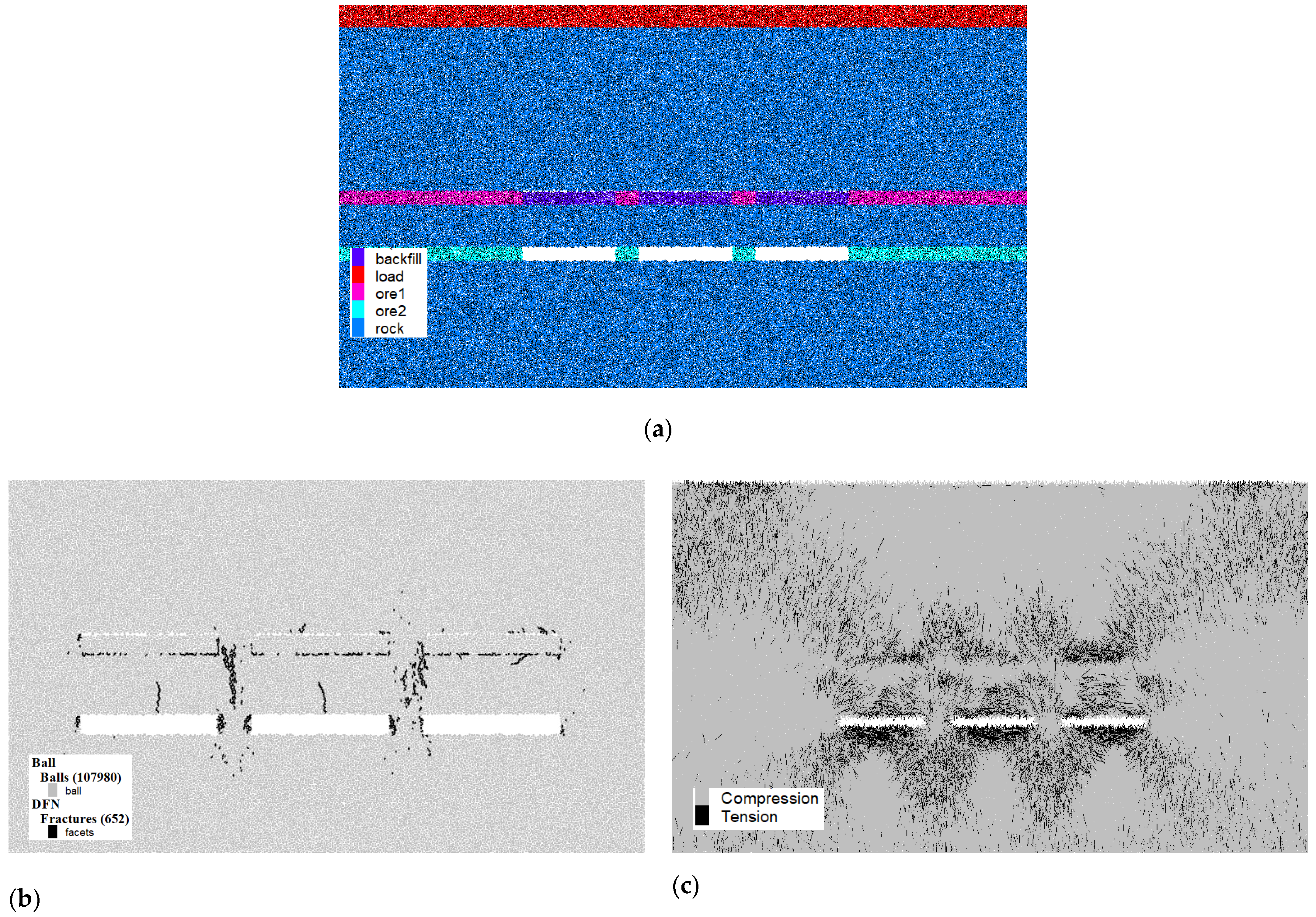
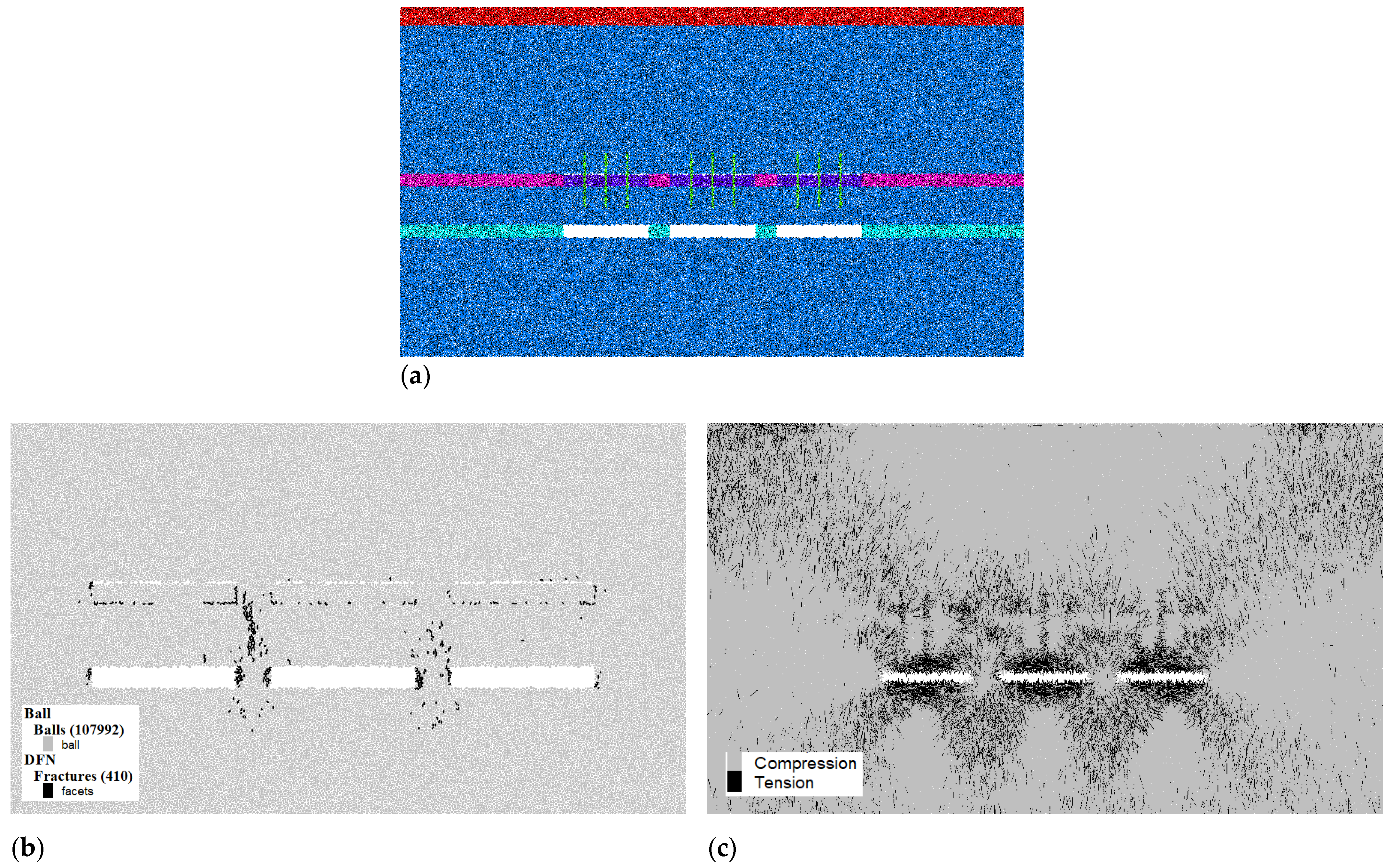
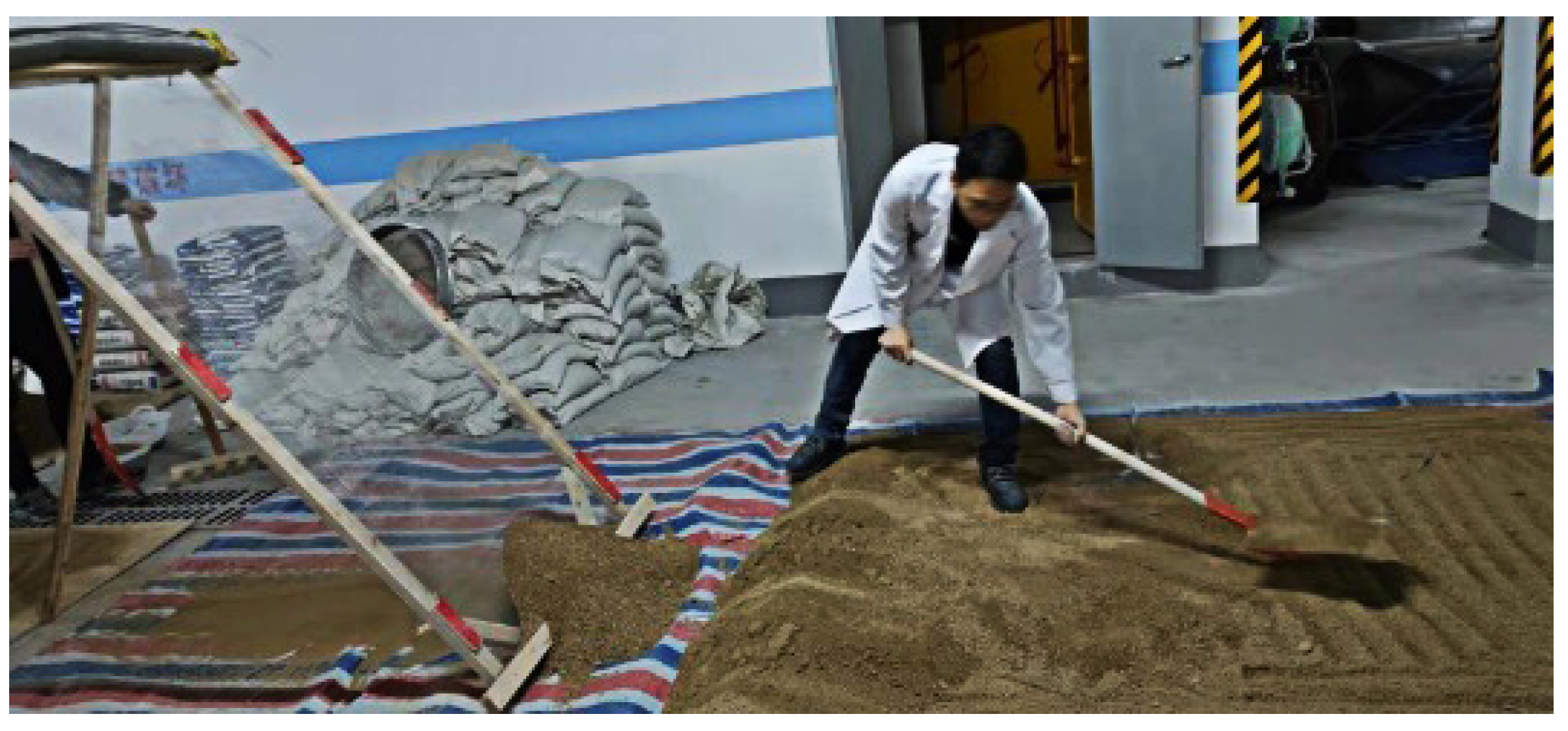
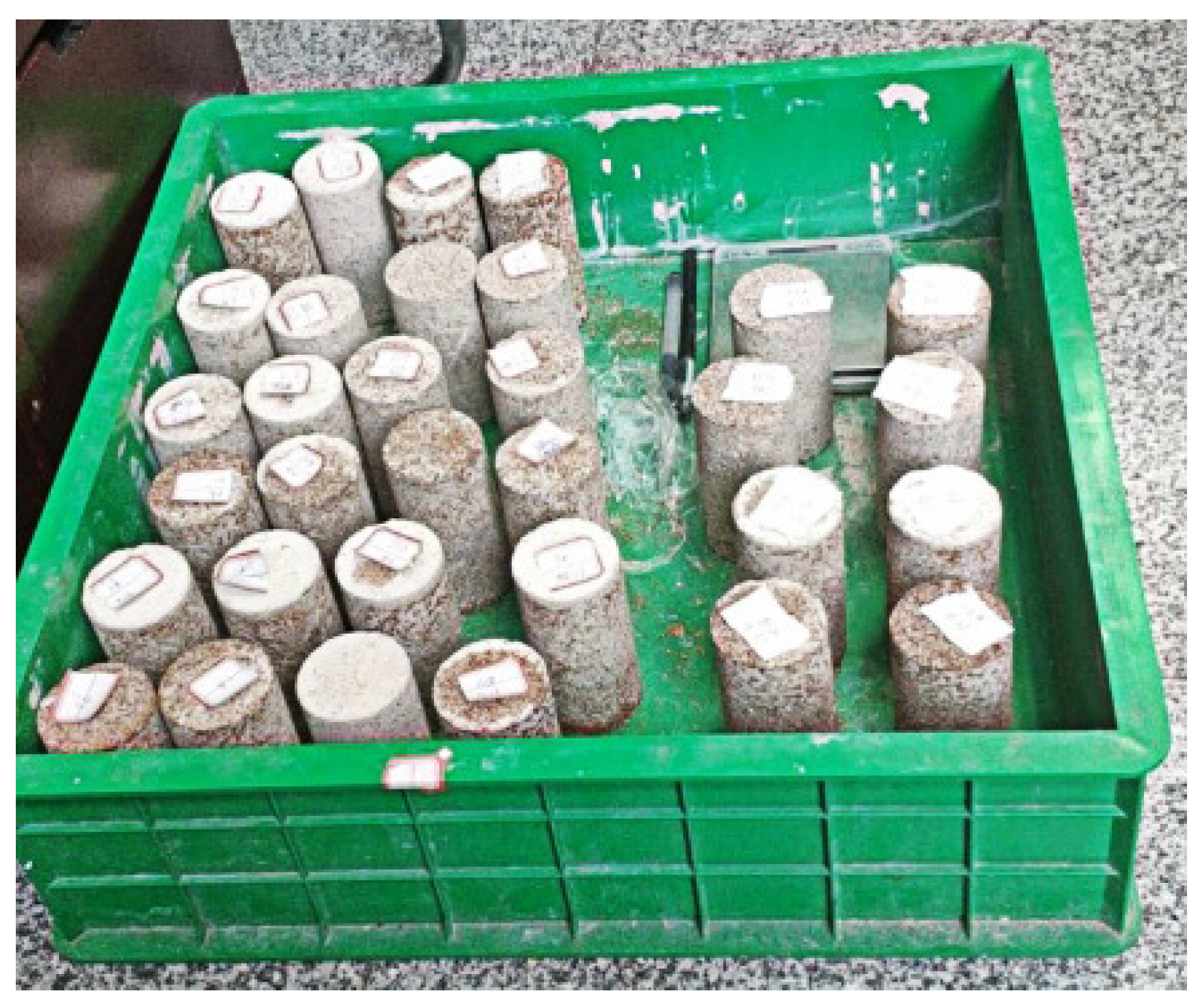

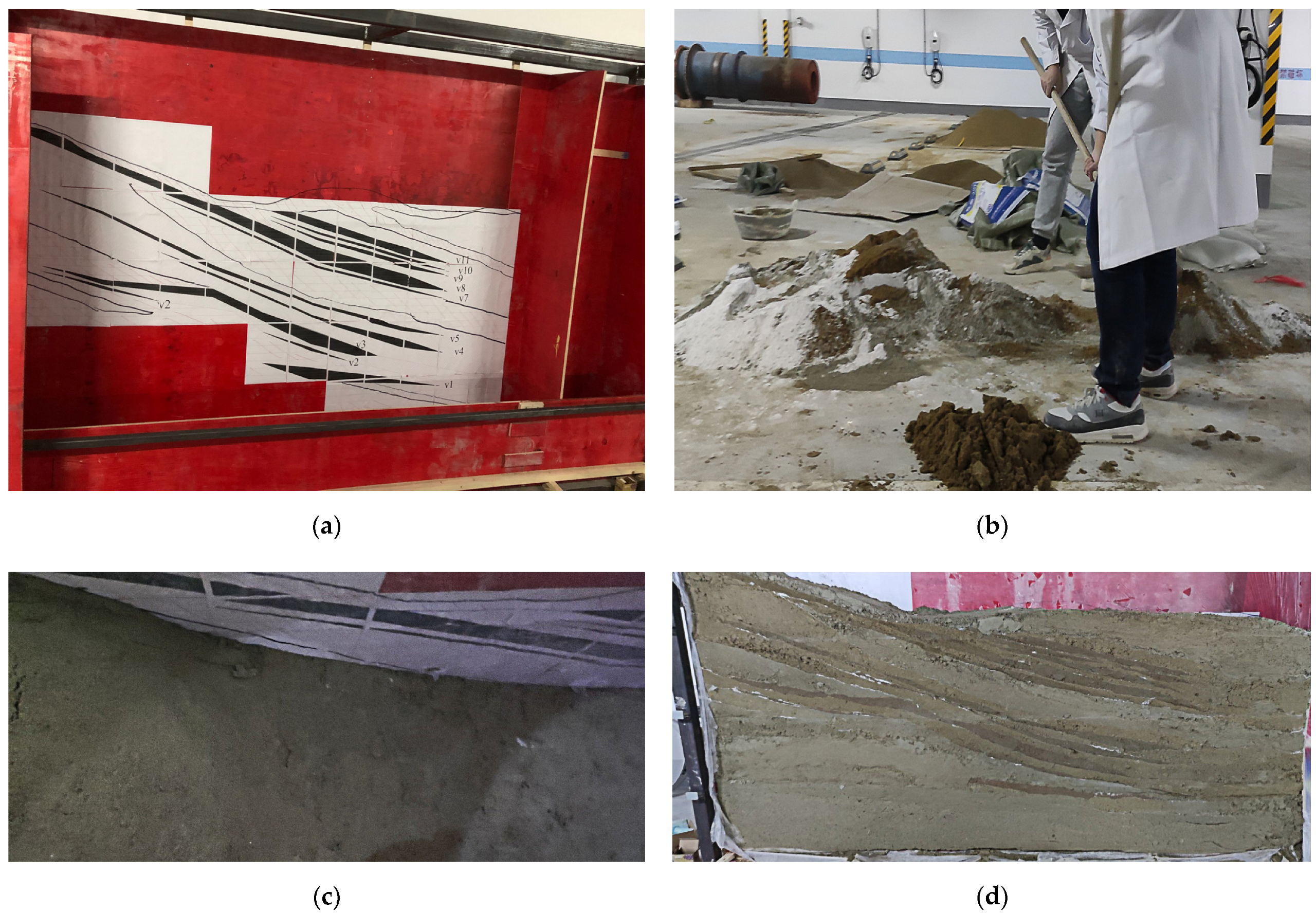

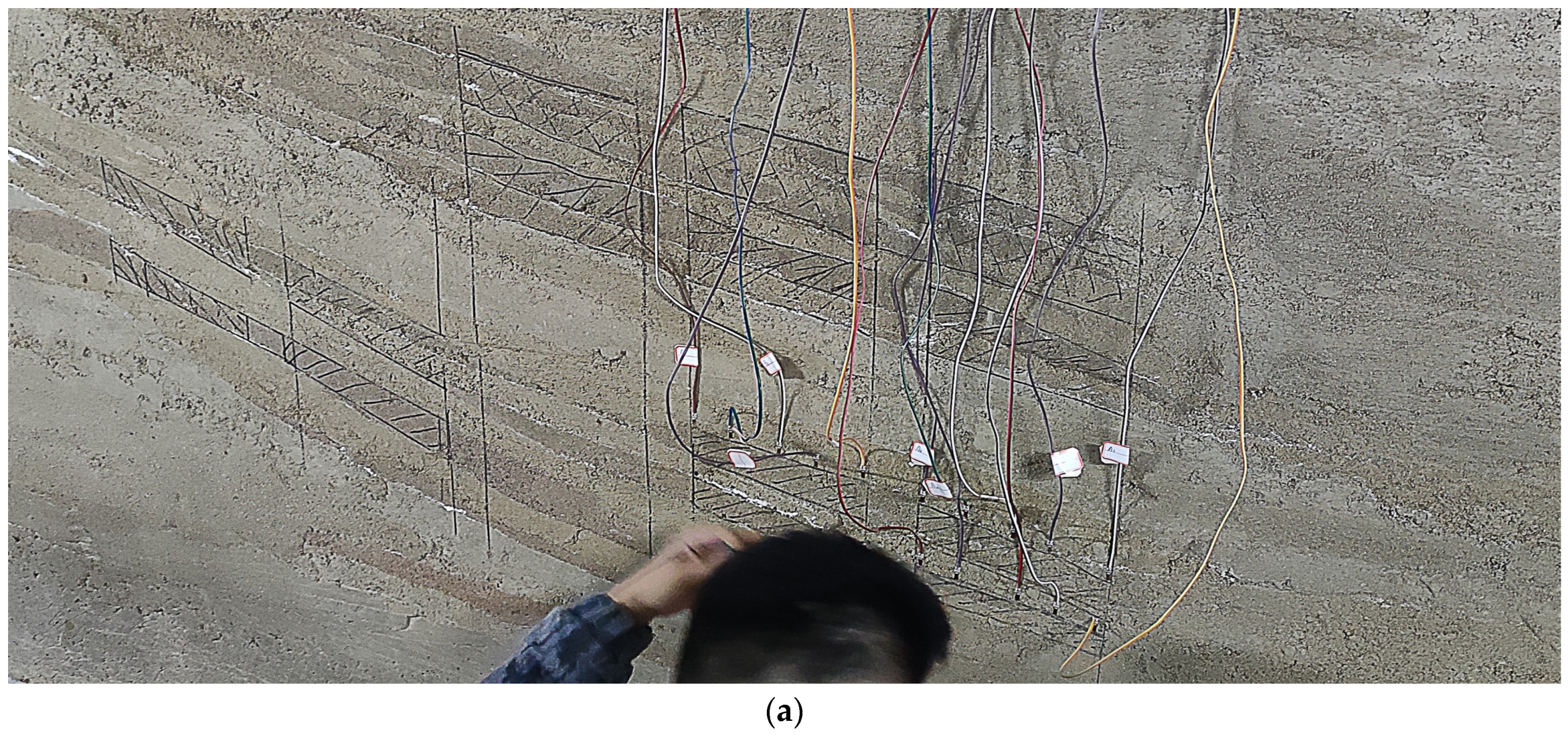
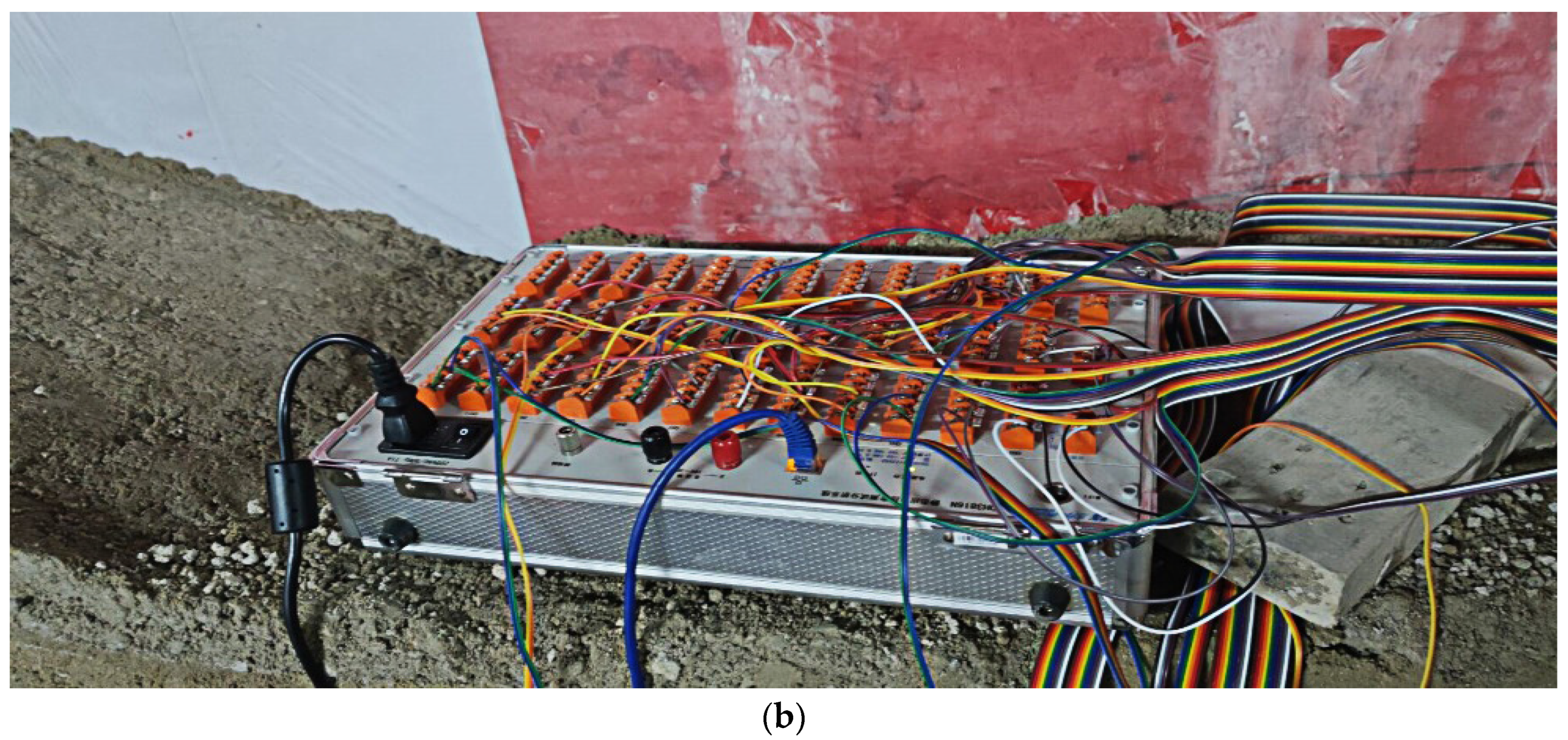
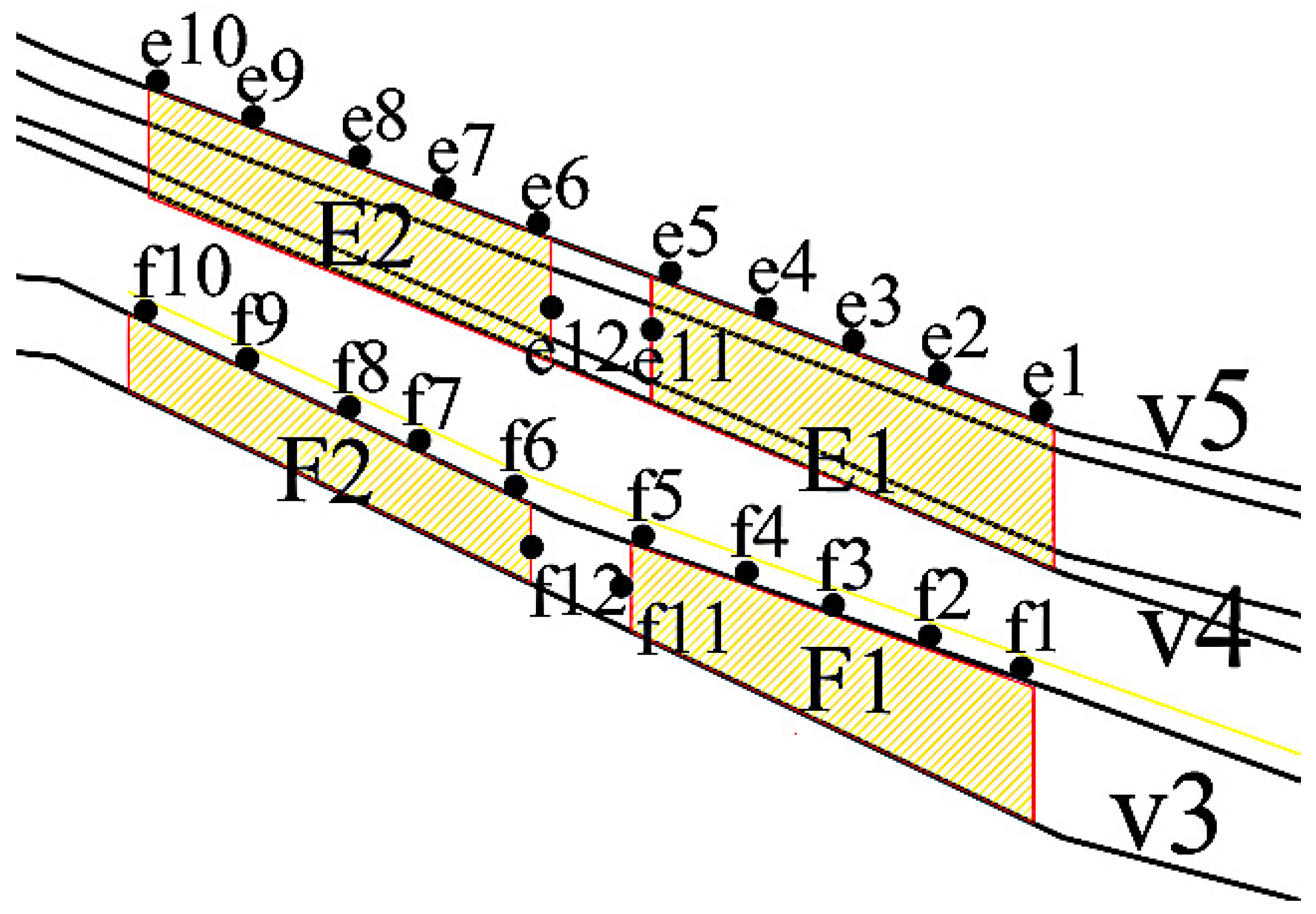
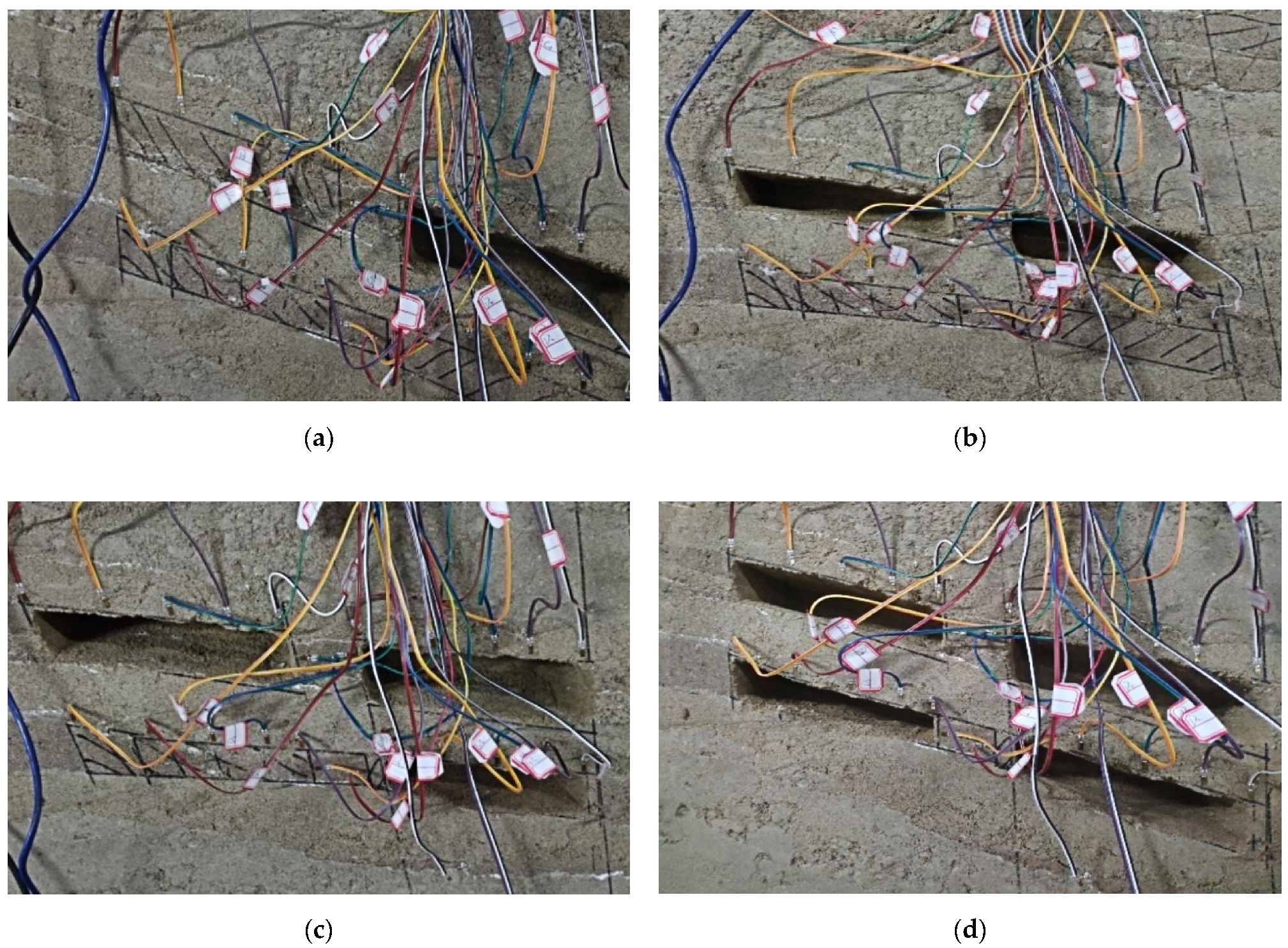
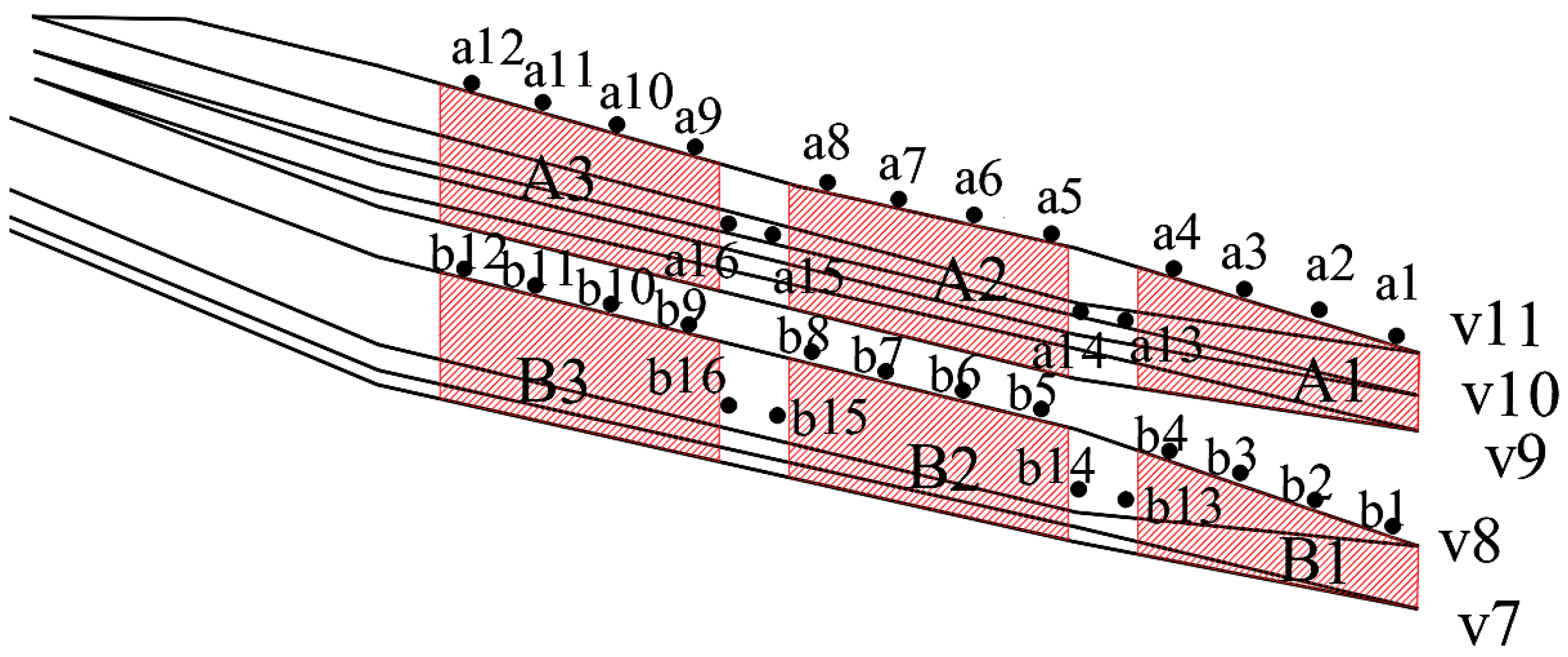
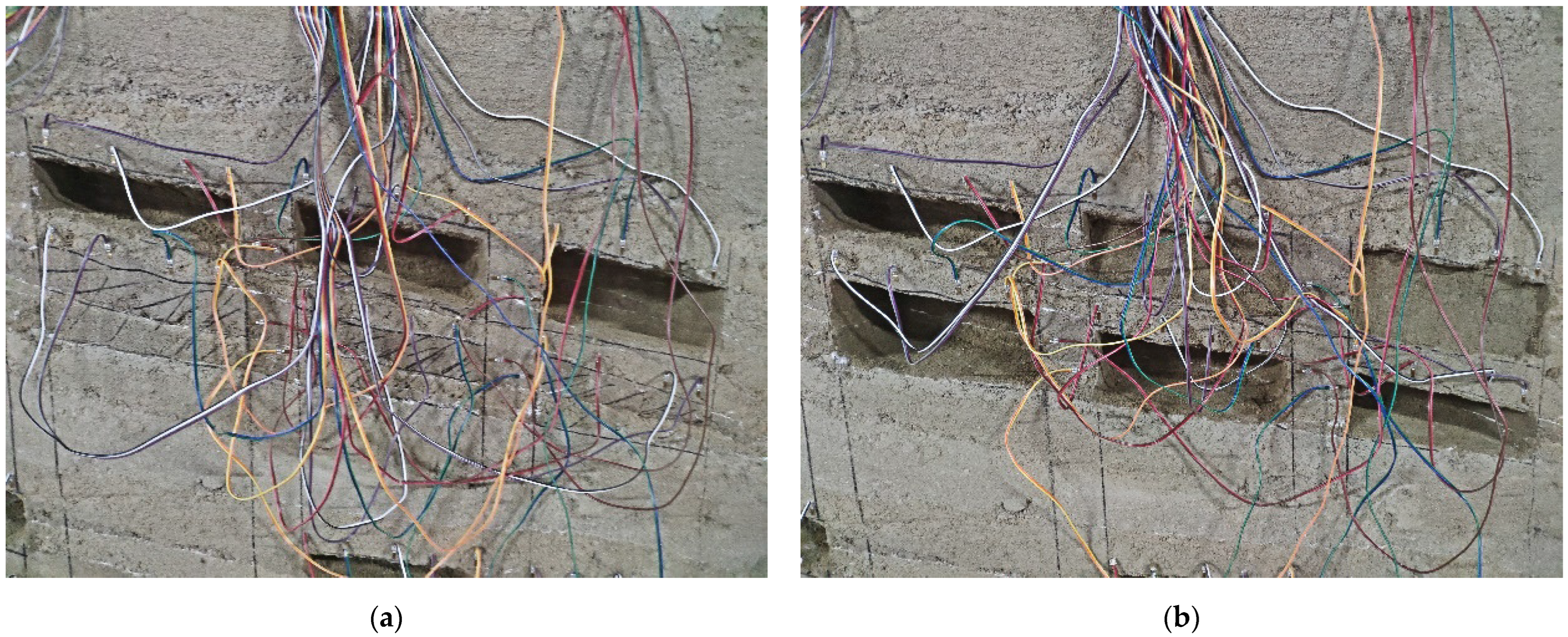
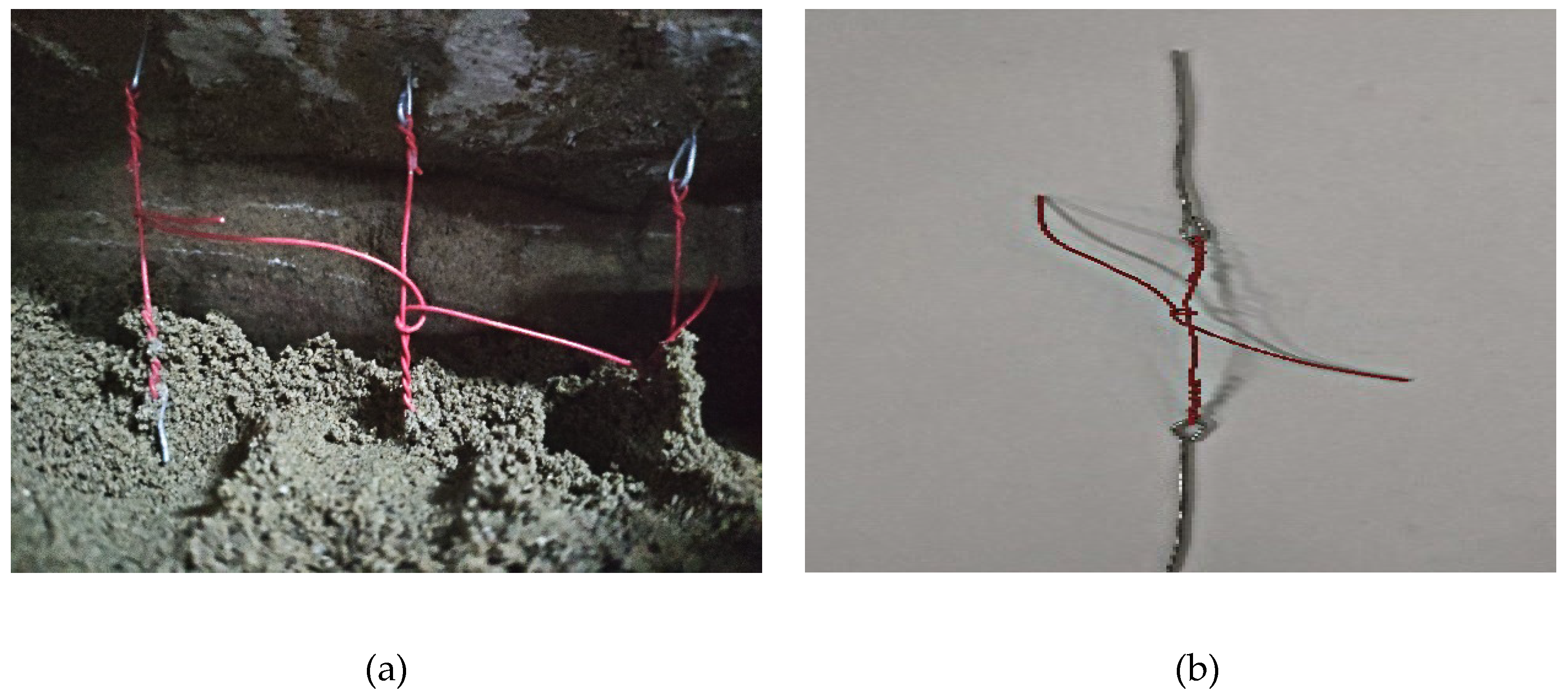
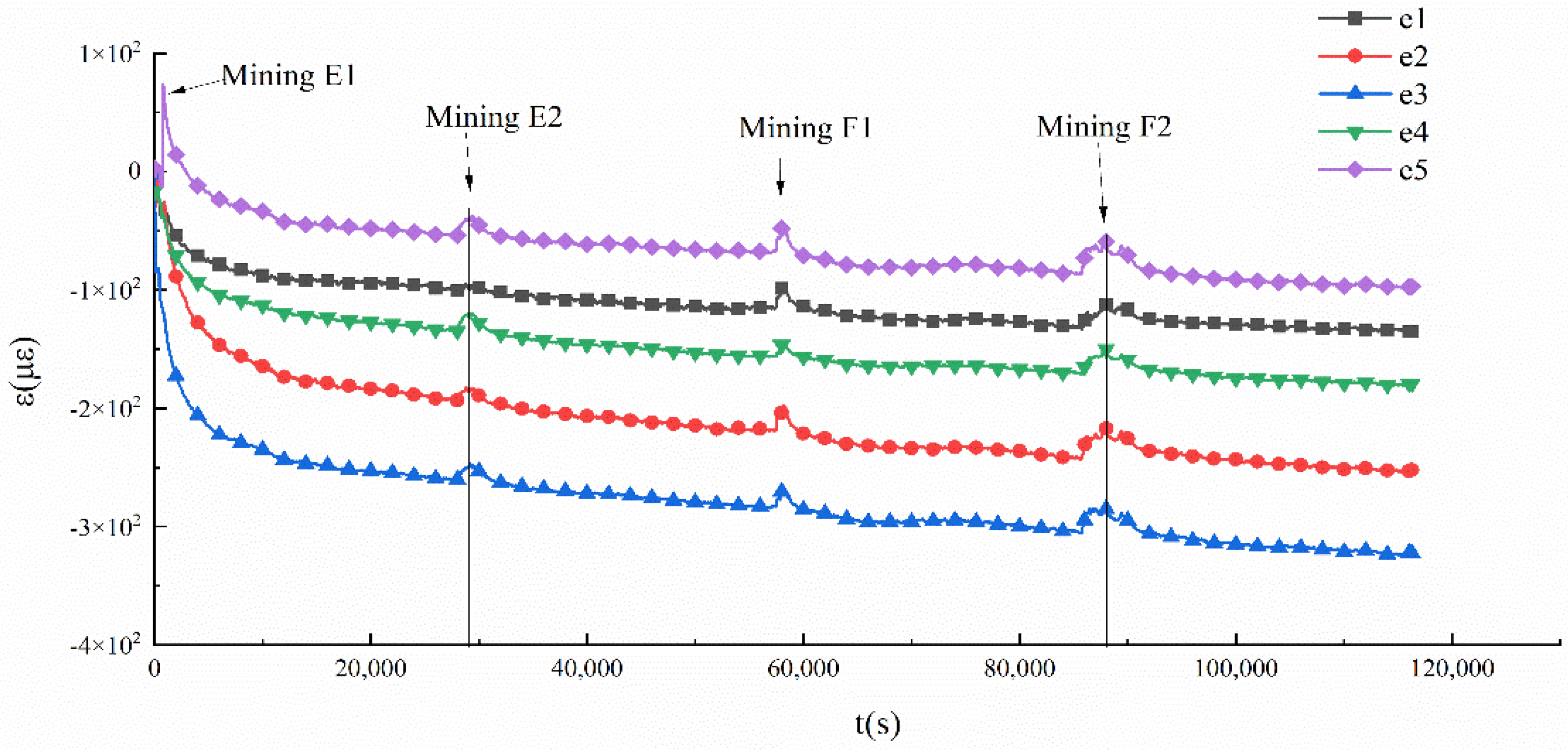
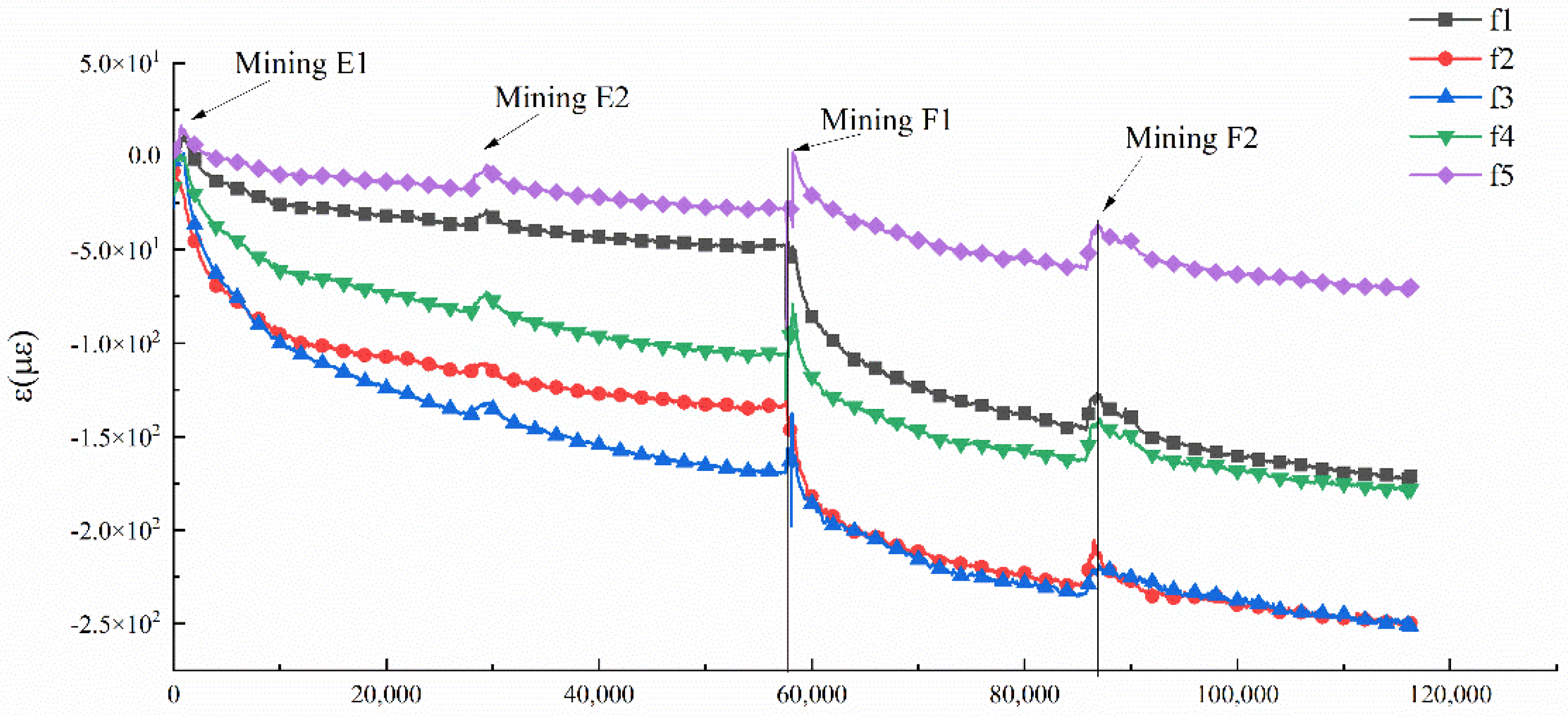
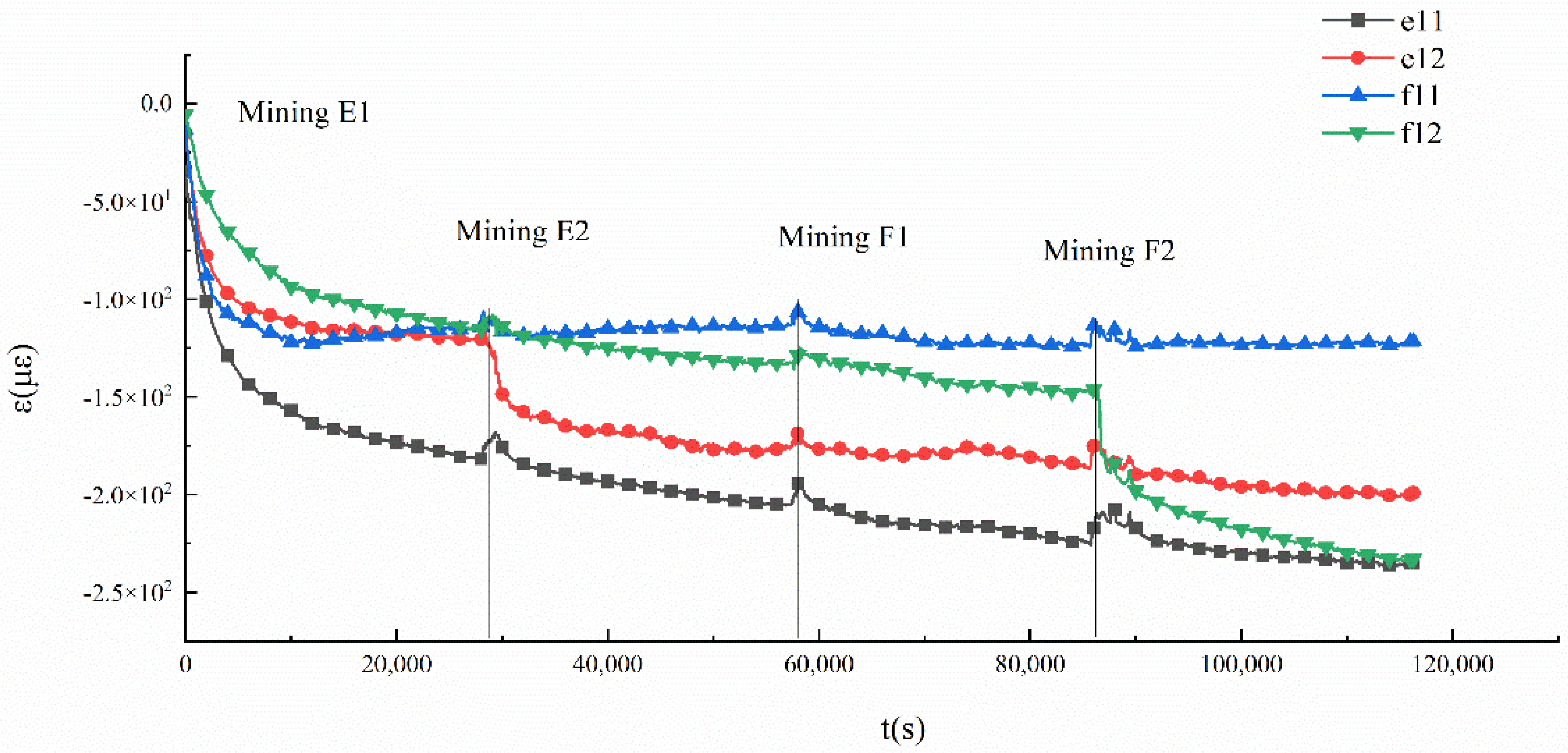
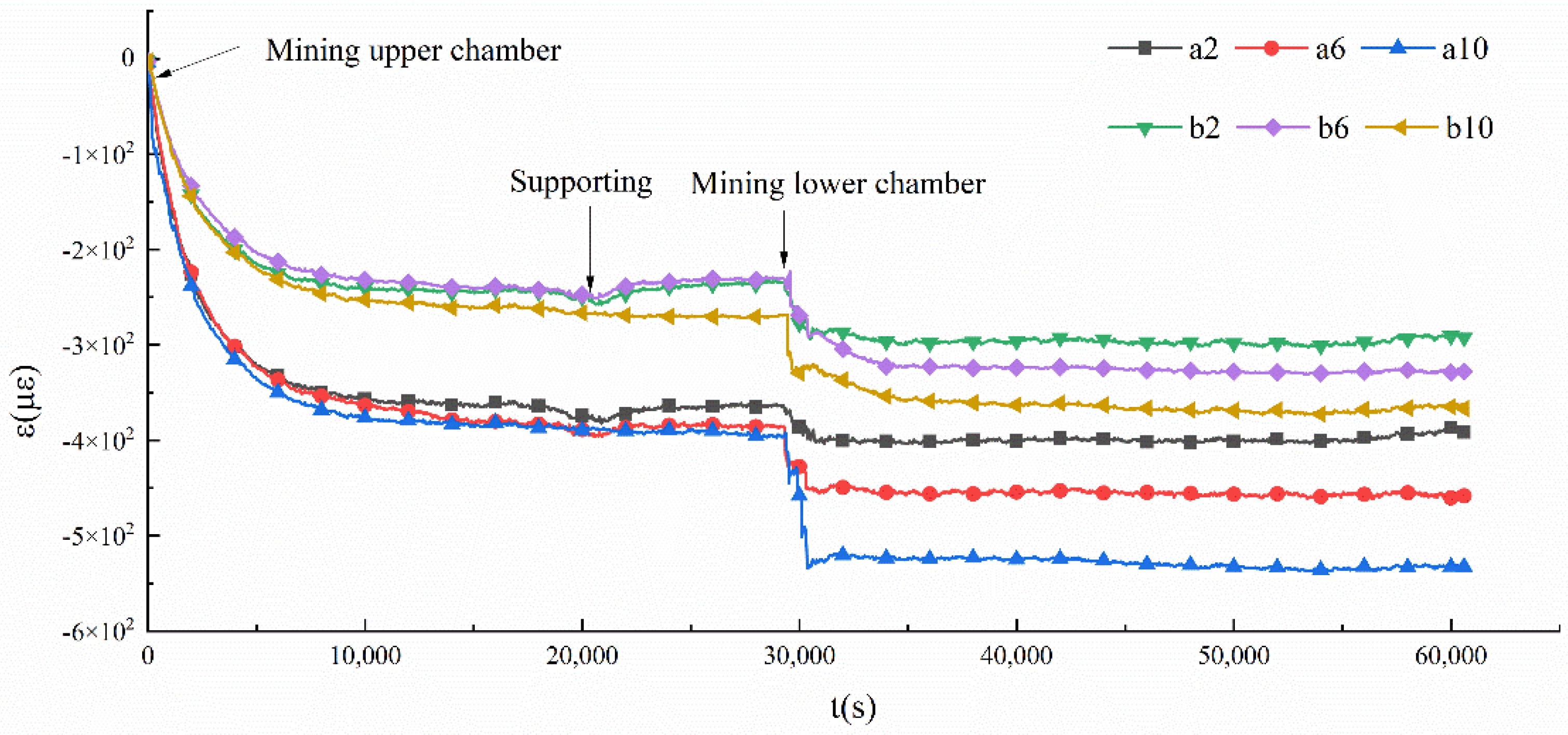
| Rocks | E (GPa) | |||
|---|---|---|---|---|
| Ore | 1.09 | 0.22 | 1.33 | 0.23 |
| Surrounding Rock | 1.48 | 0.20 | 2.35 | 0.30 |
| Rocks | C (Mpa) | Ec (Gpa) | |||
|---|---|---|---|---|---|
| Ore | 0.37 | 0.75 | 0.56 | 0.70 | 1.84 |
| Surrounding Rock | 0.56 | 1.13 | 0.75 | 0.30 | 1.39 |
| Support Method | Number of Fractures | Fractures on the Roof of Upper Goaf | Tensile Force Chains on the Roof of Upper Goaf | Fractures on the Roof of Lower Goaf | Tensile Force Chains on the Roof of Lower Goaf |
|---|---|---|---|---|---|
| Unsupported | 1311 | Extremely developed | Dense | Extremely developed | not so dense |
| Complete filling (100%) | 379 | Not developed | Sparse | Developed | dense |
| Incomplete filling (95%) | 652 | Slightly developed | Not sparse | Developed | dense |
| Bolt-filling support | 410 | Not developed | Sparse | Not developed | sparse |
| Rock Layer | Density/(kg/m3) | Compressive Strength/MPa | Modulus of Elasticity/GPa | Poisson’s Ratio | Proportion Number |
|---|---|---|---|---|---|
| Vanadium-bearing shale | 1661.74 | 0.51 | 0.39 | 0.21 | 964 |
| Carbonaceous shale | 1620.98 | 0.33 | 0.34 | 0.20 | 1037 |
| Siliceous shale | 1704.41 | 0.75 | 0.40 | 0.21 | 837 |
| Backfill | 1232.39 | 0.02 | —— | —— | 1019 |
| Rock Layer | Volume/m3 | Total amount/kg | Cement/kg | Gypsum/kg | River Sand/kg |
|---|---|---|---|---|---|
| Vanadium-bearing shale | 0.119 | 198.19 | 11.30 | 7.53 | 169.45 |
| Carbonaceous shale | 0.588 | 953.10 | 24.69 | 57.62 | 823.13 |
| Siliceous shale | 1.237 | 2107.93 | 66.75 | 155.75 | 1780.03 |
| Backfill | 0.011 | 13.61 | 0.12 | 1.06 | 11.76 |
| Total | 1.955 | 3272.83 | 102.86 | 221.96 | 2784.37 |
| Preparation quantity | 2.350 | 3927.40 | 123.43 | 266.35 | 3341.24 |
Publisher’s Note: MDPI stays neutral with regard to jurisdictional claims in published maps and institutional affiliations. |
© 2022 by the authors. Licensee MDPI, Basel, Switzerland. This article is an open access article distributed under the terms and conditions of the Creative Commons Attribution (CC BY) license (https://creativecommons.org/licenses/by/4.0/).
Share and Cite
Chi, X.; Zhang, Z.; Li, L.; Wang, Q.; Wang, Z.; Dong, H.; Xie, Y. Numerical and Experimental Study on a Novel Filling Support Method for Mining of Closely Spaced Multilayer Orebody. Minerals 2022, 12, 1523. https://doi.org/10.3390/min12121523
Chi X, Zhang Z, Li L, Wang Q, Wang Z, Dong H, Xie Y. Numerical and Experimental Study on a Novel Filling Support Method for Mining of Closely Spaced Multilayer Orebody. Minerals. 2022; 12(12):1523. https://doi.org/10.3390/min12121523
Chicago/Turabian StyleChi, Xiuwen, Zhuojun Zhang, Lifeng Li, Qizhou Wang, Zongying Wang, Haoran Dong, and Yu Xie. 2022. "Numerical and Experimental Study on a Novel Filling Support Method for Mining of Closely Spaced Multilayer Orebody" Minerals 12, no. 12: 1523. https://doi.org/10.3390/min12121523
APA StyleChi, X., Zhang, Z., Li, L., Wang, Q., Wang, Z., Dong, H., & Xie, Y. (2022). Numerical and Experimental Study on a Novel Filling Support Method for Mining of Closely Spaced Multilayer Orebody. Minerals, 12(12), 1523. https://doi.org/10.3390/min12121523





